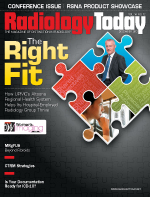 December 2013
December 2013
Turn Down the Volume — Vendors Pursue Quieter MRI Systems
By Leesha Lentz
Radiology Today
Vol. 14 No. 12 P. 12
“Noise is one of the major complaints from patients who undergo an MRI exam,” says Richard Hausmann, PhD, president and CEO of the global MR business unit of GE Healthcare. “Conventional MRI scanners can generate noise in excess of 110 dB, roughly equivalent to a jackhammer.”
Most patients are anxious before undergoing an MRI exam. They’re sick, injured, or worried about their test results to begin with, and their anxiety levels often increase when they’re placed in a loud MRI tube, according to Hausmann. Patients also may have trouble hearing the imaging staff administering the exam, which can interfere with image quality and results.
Consequently, radiology manufacturers are seeking ways to improve their MRI systems and make the experience as quiet as possible.
Noise Reduction Technologies
With the goal of mitigating these problems in the imaging room, GE Healthcare recently released Silent Scan, a combination of Silenz technology, high-fidelity gradient and radio-frequency system electronics, and fast radio-frequency switching capabilities. The main source of MR noise results from the gradient magnetic field, which creates mechanical vibrations by rapidly switching on and off with data acquisitions. The Silenz technology continuously acquires data from gradients, eliminating the repeated switching on and off and the vibrations. The high-fidelity gradient system allows for stable gradients, and the radio-frequency coil system’s fast capabilities allow the coil to switch from transmit to receive mode in lieu of switching gradients.
Currently, the technology is available only in T1 and proton density–weighted scans at 1.5T, but GE hopes to make Silent Scan available to its 3T systems in the near future.
GE is not the only manufacturer to pursue noise reduction advancements for its MRI systems. Suresh Narayan, senior manager of market development for Toshiba’s MR business unit, says the company has been implementing noise reduction technology for several years. Toshiba’s Vantage MRI systems come standard with Pianissimo technology, which seals the gradient coil in a vacuum chamber. The company claims Pianissimo can reduce the noise by 90%.
“We have a very specific hardware design where we eliminate the noise—or as much as we can—from the system so the rest of the system is not propagated with the acoustic noise,” Narayan says. ”It starts with the way we design our scanners.”
Stuart Clarkson, senior director of Siemens Healthcare’s MR business unit, says there are many ways to reduce the noise level in MRI systems. “We actually included a lot of hardware that can mitigate noise, such as mounting in the gradient coil that will help suppress that noise and to mitigate the movement of the coil,” he explains.
Siemens also offers its whisper-mode noise reduction solution for less demanding imaging. “When you are doing more demanding imaging, you try to make the gradient turn on and off very quickly, but a lot of the time, we don’t need to make the gradient coil work as hard as that to get a very good image,” Clarkson says. “We can make the gradient go into this whisper mode to reduce the amount of current that is needed and doesn’t have to play out as such aggressive wave forms. That has a significant reduction on the acoustic noise level.”
Patient Satisfaction
While these manufacturers have found different ways to mitigate MRI-related noise, they all agree that the end product has improved the patient experience, especially for those requiring long exams. Noise reduction technology enables patients to hear the technologist or family members inside the scan room—significant comforts during a sometimes-stressful procedure.
“With conventional scans, technologists, radiologists, and patients had to listen to the loud clanging of the MRI all day long,” Hausmann says. “With Silent Scan, patients can now hear the technologist during the scan and comforting words from families. Imagine a small child being scanned who before would have to listen to the clanging of the MRI but now, with Silent Scan, can hear his mother comforting him. The patient, the staff, and the patient’s family can now communicate during the scan, leading to a better experience for everyone.”
Narayan and Clarkson say some patients choose to wear headphones but not because they want to reduce the loud noises associated with conventional scans. Patients can bring in their iPod or CDs to listen to while they are being scanned, swapping out the old “jackhammer” noise for their favorite songs.
“All of these things make them much more at ease when they are in the MRI scanner, and it is important to serve our customers in that way and make sure the patient is satisfied,” Narayan says. “In today’s health care environment, one of the most important things is patient satisfaction.”
— Leesha Lentz is an editorial assistant at Radiology Today.

